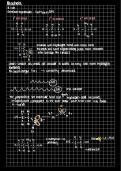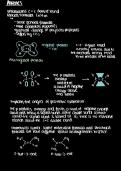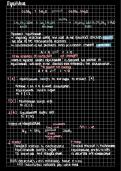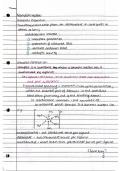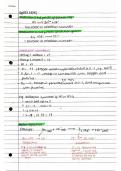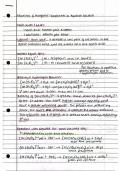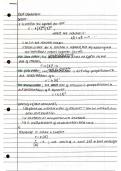AQA • A Level Chemistry
Latest uploads for A Level Chemistry at AQA. Looking for A Level Chemistry notes at AQA? We have lots of notes, study guides and revision notes available for A Level Chemistry at AQA.
-
1051
-
16
-
132
Modules A Level Chemistry at AQA
Notes available for the following courses of A Level Chemistry at AQA
- A-Level Chemistry 14
- Alkenes 1
- All 7
- All AQA Chemistry Mechanisms 1
- All Chemical Equations 1
- All Chemistry units 7405 1
- All modules 1
- All of A level Chemistry 3
- All units 7405 2
- Aqa 7
- AQA A Level Chemistry 2020 Paper 2 1
- AQA A level Chemistry Marking Scheme Paper 1 1
- AQA A Level Chemistry Paper 2 1
- AS Chemistry 1
- AS inorganic chem 1
- AS Inorganic chemistry 1
- AS organic 1
- AS Organic Chemistry 3
- AS physical summary 1
- Atomic Structure 1
- OCR A-level Chemistry - Full summary notes H432 1
- Orbitals, Electronic Configurations, Period Table 1
- Organic and Physical Chemistry Chemistry 2
- Organic Chemistry 7405 4
- Organic Chemistry Year 12 1
- Organic Mechanisms 7405 1
- Organic pathway as Chem 1
- Organic Reactions 7405 1
- Organic, Inorganic and Physical 1
- Unit 1.1 - Atomic structure 1
- Unit 1.2 - Amount of substance 1
- Unit 3.1- Physical chemistry 7405 1
- Unit 3.1.1 - Atomic structure 7405 66
- Unit 3.1.1-6 7404 1
- Unit 3.1.11 - Electrode potentials and electrochemical cells 23
- Unit 3.1.12 - Acids and bases 7405-1 30
- Unit 3.1.2 - Amount of substance 7405 36
- Unit 3.1.3 - Bonding 74041 42
- Unit 3.1.4 - Energetics 74041 29
- Unit 3.1.5 - Kinetics 74041 27
- Unit 3.1.6 - Chemical equilibria, Le Chatelier’s principle and Kc Chemistry 30
- Unit 3.1.7 - Oxidation, reduction and redox equations 18
- Unit 3.1.8 - Thermodynamics Chem 35
- Unit 3.1.9 - Rate Equations 1
- Unit 3.2.1 - Periodicity 25
- Unit 3.2.1-3 74041 4
- Unit 3.2.2 - Group 2, the alkaline earth metals 24
- Unit 3.2.3 - Group 7, the halogens 74041 21
- Unit 3.2.4 - Properties of Period 3 elements and their oxides Chemistry 20
- Unit 3.2.5 - Transition metals 7405-1 38
- Unit 3.2.6 - Reactions of ions in aqueous solution 12
- Unit 3.3 7405-2 1
- Unit 3.3.1 - Introduction to organic chemistry chemistry 39
- Unit 3.3.1-6 7404 6
- Unit 3.3.10 - Aromatic chemistry Benzene 76
- Unit 3.3.11 - Amines 7405-2 14
- Unit 3.3.12 - Polymers 13
- Unit 3.3.13 - Amino acids, proteins and DNA 7405-2 25
- Unit 3.3.14 - Organic synthesis 15
- Unit 3.3.15 - Nuclear magnetic resonance spectroscopy 10
- Unit 3.3.16 - Chromatography 8
- Unit 3.3.2 - Alkanes 7405 29
- Unit 3.3.3 - Halogenoalkanes 24
- Unit 3.3.4 - Alkenes 21
- Unit 3.3.5 - Alcohols Chem 26
- Unit 3.3.6 - Organic analysis Chem 19
- Unit 3.3.7 - Optical isomerism 7405 16
- Unit 3.3.8 - Aldehydes and ketones 14
- Unit 3.3.8-9 7405-2 1
- Unit 3.3.9 - Carboxylic acids and derivatives 7405 16
Popular books AQA • A Level Chemistry
Latest notes & summaries AQA • A Level Chemistry
Organic analysis in A-Level Chemistry under the AQA specification involves the identification and characterization of organic compounds using a variety of techniques. Here’s a brief summary of the key aspects: 1. Functional Group Analysis Test for Alkenes: Bromine water test. Alkenes decolorize bromine water (from orange to colorless). Test for Alcohols: Primary and Secondary Alcohols: Oxidation with acidified potassium dichromate (orange to green). Tertiary Alcohols: No reaction with a...
Alcohols are a class of organic compounds characterized by the presence of one or more hydroxyl (-OH) groups attached to a carbon atom. Here are the key points about alcohols relevant to A-level chemistry: Structure and Classification General Formula: The general formula for alcohols is C n H 2 n + 1 O H C n H 2n+1 OH. Functional Group: The defining feature of alcohols is the hydroxyl (-OH) group. Classification: Alcohols are classified based on the number of...
Alkenes are a class of hydrocarbons that contain at least one carbon-carbon double bond (C=C). Here are the key points about alkenes: Structure General Formula: The general formula for alkenes is C n H 2 n C n H 2n , where n n is the number of carbon atoms. Double Bond: The presence of a carbon-carbon double bond defines alkenes. This double bond consists of one sigma (σ) bond and one pi (π) bond. Nomenclature Naming: Alkenes are named by identifying the lo...
Oxidation, reduction, and redox equations are fundamental concepts in chemistry, particularly in the study of chemical reactions involving electron transfer. Oxidation Definition: Oxidation is the process where an atom, ion, or molecule loses one or more electrons. Oxidation State: The oxidation state (or oxidation number) of the species increases. Example: In the reaction Fe → Fe 2 + + 2 e − Fe→Fe 2+ +2e − , iron (Fe) is oxidized to iron(II) ion (Fe²⁺). Redu...
Chemical equilibrium occurs in a chemical reaction when the rate of the forward reaction equals the rate of the reverse reaction, resulting in no net change in the concentrations of reactants and products. At equilibrium, the system is dynamic, meaning the reactions continue to occur, but the concentrations of the reactants and products remain constant over time. The equilibrium constant, K c K c , is a numerical value that expresses the ratio of the concentrations of products t...
Digital notes on Period 3 oxides for AQA A-level chemistry, unit 3.2.4. It contains the trends across period 3, reactions of period 3 oxides as well as tips on answering exam questions on this topic. Notes are easy to read and neatly laid out. (Actual PDF is in a normal layout - different to preview on Stuvia).
In depth notes on the 'Transition metals' topic for the AQA A-Level Chemistry course. Includes detailed explanations, equations with observations and key concepts to learn for the exam, Specifically goes through catalysts, oxidation states, ligand substitution, and complex formation. Written by an A* student.
In depth notes on the 'Redox' topic of the AQA A-Level Chemistry course. Includes key definitions, detailed explanations, and equations.
In depth notes on the 'Reactions of Ions in Aqueous Solution' topic in the AQA A-Level Chemistry course. Includes observations and equations for memorisation, and a summary page. Written by an A* student.
In depth notes on the 'Rate equations' topic of the AQA A-Level Chemistry course. Includes examples, detailed explanations and definitions, including for the rate determining step.



